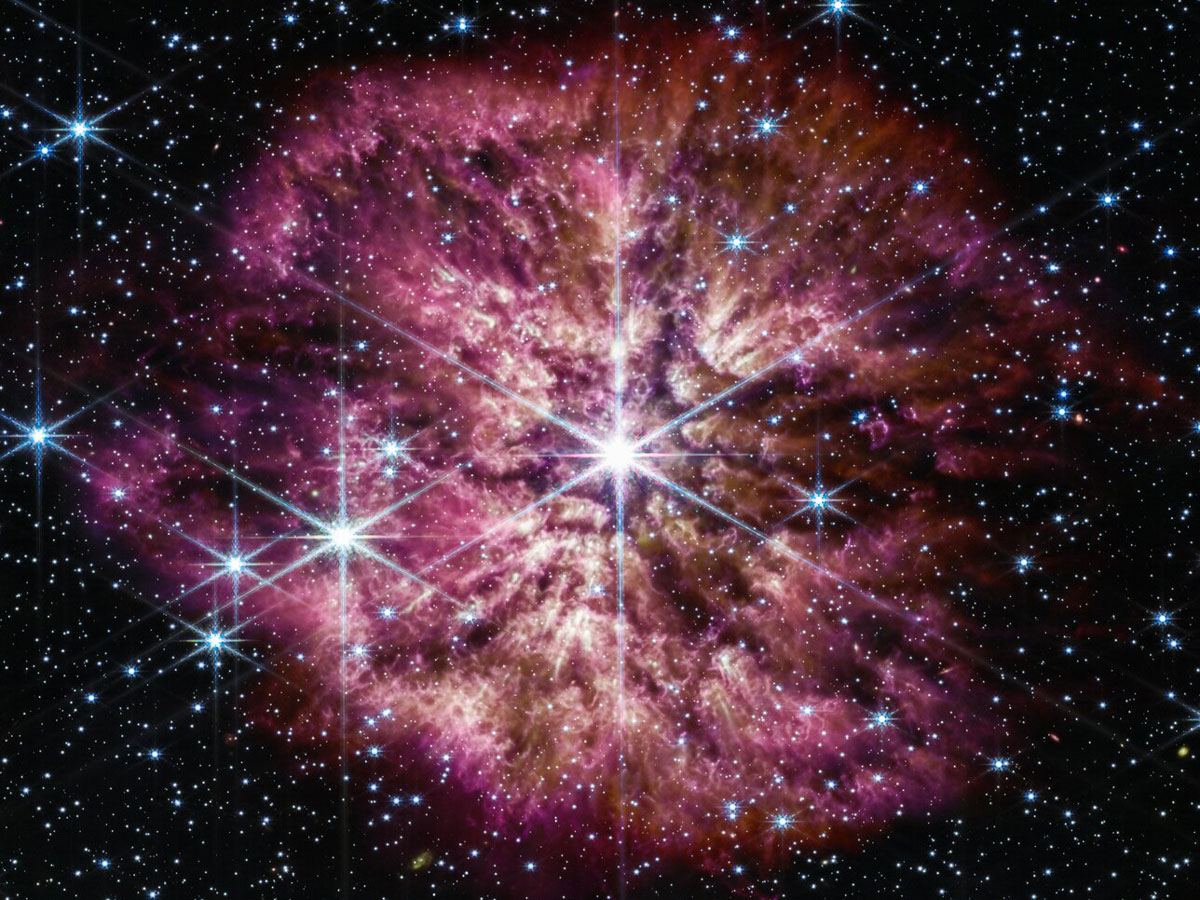Two billion years ago, a massive star exploded. When its light reached Earth in 2021, it joined more than 20,000 recorded supernova candidates observed that year.
This one was unique, however. It exhibited features not shared by any other known stellar explosion: The star had shed almost all of its outer layers before it died, exposing a core rich in silicon and sulfur.
SN 2021yfj, as this supernova is labeled, revealed never before seen details about stellar interiors. Precisely how a star could die this way is a marvelous puzzle that may help researchers learn about the deaths of the most massive stars and how they spread new elements through the cosmos.
“By studying supernovae, we can develop ideas of how stars form, evolve, and die,” said Steve Schulze of Northwestern University in Illinois, who led the observations and analysis of SN 2021yfj, published in Nature.
Onions Have Layers, Stars Have Layers
All stars, including the Sun, spend the majority of their life cycles fusing hydrogen into helium in their cores, which are surrounded by a hydrogen plasma envelope. When this fuel is exhausted, the core contracts and begins fusing helium into carbon and oxygen. For the most massive stars (those at least 8 times the mass of the Sun) this process continues to fuse heavier and heavier elements in the core.
The result is an onion-like (or ogre-like) character of aging high-mass stars: a hydrogen envelope surrounding a shell of helium, around a shell of carbon and oxygen. Layers of neon, magnesium, silicon, sulfur, and higher-mass nuclei form deeper toward the core. Eventually the energy produced by fusion is no longer able to maintain the core’s integrity, at which point the star explodes as a supernova.
This is the story theory tells, at least; these shells aren’t visible to telescopes. Astronomers must deduce the makeup of interiors from the spectrum of light stars emit when they explode.
“The spectra of supernovae are their fingerprints.”
“The spectra of supernovae are their fingerprints,” said Maryam Modjaz, an astronomer at the University of Virginia who was not involved in the study. She called this type of research stellar forensics. “We see the explosion of the star and we work backwards.”
However, very massive stars shed a great deal of their outer envelopes long before they explode, as astronomers observed during the dramatic dimming of Betelgeuse in 2019. Some extremely massive specimens known as Wolf-Rayet (pronounced “rah-YAY”) stars expel their envelopes much earlier in their lifetimes. The most commonly observed type of Wolf-Rayet stars consist of a hydrogen nebula swathing the extremely hot layers surrounding the core, which is dominated by emissions from helium and carbon.
I Like That Spectrum—That Is a Nice Spectrum
SN 2021yfj took this early-shedding process further than any other star yet observed: It had shed not only its hydrogen envelope, but also its helium, carbon, and oxygen shells. The spectrum Schulze and his colleagues measured exhibited emissions from ionized silicon and sulfur, indicating the progenitor had ejected that layer before exploding.
“The progenitor star [of supernova 2021yfj] had essentially lost almost all of its shells,” Schulze said. Astronomers have observed other stars that have been stripped of their outer layers, but never to this extreme.
“We have spectra from hundreds of thousands of supernovae, [and] this is the first time we’ve seen deep into the guts of a dying star.”
Though that provided strong evidence supporting the onion model for high-mass stars, it also was surprising: Nobody expected a star to shed that much material before going supernova.
“We have spectra from hundreds of thousands of supernovae, [and] this is the first time we’ve seen deep into the guts of a dying star,” Modjaz said. “This must be a very unique, very uncommon explosion and therefore [uncommon] progenitor.”
“The properties of supernova 2021yfj are so extreme that it’s challenging to find a model that can describe all of the observations,” Schulze said.
“Our leading hypothesis or leading idea,” he continued, “is that it was a very massive star, around 60 times more mass than the Sun.” Because it had already shed its hydrogen and helium by the time it was observed, though, the star was probably even more massive when it was born. He cautioned against trying to make too many guesses based on the data so far. “Exactly how massive it was will require very detailed simulations [and] the development of models that don’t exist yet.”
Schulze noted that even with hundreds of thousands of identified supernovae, astronomers have yet to see all the possible types. To make things more challenging, supernovae—bright as they are—are single points of light that fade over a matter of days, so spotting them often involves a degree of luck. Extreme stripped-core supernovae are so rare, just by probability astronomers will find tens of thousands more typical explosions before the next example turns up in their data.
However, that task is less daunting than it sounds.
In addition to the Zwicky Transient Facility where astronomers detected SN 2021yfj, Schulze and Modjaz both hailed the Vera C. Rubin Observatory, which is expected to detect a thousand supernovae each night of operation when it comes online in 2026. Though that telescope isn’t being built for spectroscopy, its ability to scan huge swaths of the sky at once will let astronomers identify explosions to analyze in more detail quickly, bringing us closer to an understanding of how massive stars live and die.
—Matthew R. Francis (@BowlerHatScience.org), Science Writer

